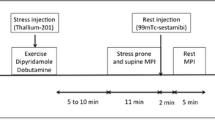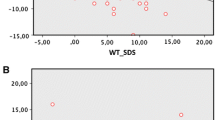Abstract
Measurements of myocardial perfusion and ventricular function are expected to provide additional information in the detection of coronary artery disease (CAD). The purpose of this study was threefold: (1) to determine to what extent technetium-99m sestamibi wall motion yields different information compared with99mTc-sestamibi and thallium-201 perfusion; (2) to test which information unique to either study is of value in diagnosing CAD; and (3) to assess the combination of variables with the highest diagnostic accuracy. Perfusion and wall motion scores (at rest and during exercise) obtained from visual and quantitative planar201T1 and99mTc-sestamibi scintigraphy of 60 patients with suspected CAD were compared with the angiographic results by means of a polytomous logistic regression model and the diagnostic values were compared with one another. All univariate variables were significantly related to the probability of CAD and its extent. Comparative studies revealed a large degree of correlation between201T1 stress and redistribution variables. The rest99mTc-sestamibi and wall motion studies contained partially different information. Stepwise logistic regression analysis showed the strongest diagnostic power for the combination of201Tl visual analysis of the stress images with quantitative redistribution images (sensitivity 93%, specificity 71%). The diagnostic power was similar for all combinations of visual and quantitative analyses of the exercise and redistribution images. The strongest diagnostic power of the99mTc-sestamibi variables was the score of the diastolic stress image (sensitivity 91%, specificity 79%). Comparable sensitivity and specificity estimates were found when both optimal models were compared. Wall motion studies did not have additional diagnostic power. Although99mTc-sestamibi wall motion studies, both at rest and during exercise, provide information in addition to the99mTc-sestamibi or201Tl myocardial perfusion variables, the information does not enhance the diagnostic power with regard to the prediction of CAD.
Similar content being viewed by others
References
Wackers FIT, Berman DS, Maddahi J, et al. Technetium-99m hexakis 2-methoxy-isobutyl isonitrile: human biodistribution, dosimetry, safety and preliminary comparison to thallium-201 for myocardial perfusion imaging.J Nucl Med 1989; 30: 301–311.
Kahn JK, McGhie I, Akers MS, et al. Quantitative rotational tomography with201Tl and99mTc-methoxy-isobutyl-isonitrile. A direct comparison in normal individuals and patients with coronary artery disease.Circulation 1989; 79: 1282–1293.
Najm YC, Maisey MN, Clarke SM, Fogelman I, Curry PVL, Sowton E. Exercise myocardial perfusion scintigraphy with technetium-99m-methoxy isobutyl-isonitrile: a comparative study with thallium-201.Int J Cardiol 1990; 26: 93–102.
Verzijlbergen JF, Cramer MJ, Niemeyer MG, Ascoop CAPL, van der Wall EE, Pauwels EKJ. ECG-gated and static technetium-99m-sestamibi planar myocardial perfusion imaging: a comparison with thallium-201 and study of observer variabilities.Am J Physiol Imaging 1990; 5: 60–67.
Kiat H, Maddahi J, Roy LT, et al. Comparison of technetium-99m-methoxy isobutyl-isonitrile and thallium-201 for evaluation of coronary artery disease by planar and tomographic methods.Am Heart J 1989; 117: 1–11.
Alderson PO, Wagner HN Jr, Gomez-Moeiras JJ, et al. Simultaneous detection of myocardial perfusion and wall motion by cinematic Tl-201 imaging.Radiology 1978; 127: 531–533.
Verani MS, Marcus ML, Razzak MA, Ehrhardt JC. Sensitivity and specificity of thallium-201 perfusion scintigrams under exercise in the diagnosis of coronary artery disease.J Nucl Med 1978; 19: 773–782.
Garry I, Kardontchik A. Study of ECG- gated thallium-201 myocardial scintigraphy. Is imaging time a limiting factor?Eur J Nucl Med 1984; 9: 173–176.
Kahn JK, Henderson EB, Akers MS, et al. Gated and ungated tomographic perfusion imaging with technetium-99m RP30A, comparison with Tl-201 tomography in coronary artery disease [abstract].J Am Coll Cardiol 1988; 11: 32A.
Sporn V, Perez Balino N, Holman BL, et al. Simultaneous measurement of ventricular function and myocardial perfusion using the technetium-99m isonitriles.Clin Nucl Med 1988; 13: 77–81.
Iskandrian AS, Heo J, Kong B, Lyons E, Marsch S. Use of technetium-99m-isonitrile (RP30) in assessing left ventricular perfusion and function at rest and during exercise in coronary artery disease, and comparison with coronary arteriography and exercise thallium-201 SPECT imaging.Am J Cardiol 1989;64:270–275.
Villanueva-Meyer J, Mena I, Narahara K. Simultaneous assessment of left ventricular wall motion and myocardial perfusion with tech netium-99m-methoxy isobutyl-isonitrile at stress and rest in patients with angina: comparison with thallium-201 SPECT.J Nucl Med 1990; 31: 457–463.
Borges-Neto S, Coleman E, Jones RH. Perfusion and function at rest and treadmill exercise using technetium-99m-sestamibi: comparison of one- and two-day protocols in normal volunteers.J Nucl Med 1990; 31: 1128–1132.
Larock MP, Cantineau R, Legrand V, Kulbertus H, Rigo P. Tc99m-MIBI (RP30) to define the extent of myocardial ischemia and evaluate ventricular function.Eur J Nucl Med 1990; 16: 223–230.
Jones RH, Borges-Nete, S, Potts JM. Simultaneous measurement of myocardial perfusion and ventricular function during exercise from a single injection of technetium-99m sestamibi in coronary artery disease.Am J Cardiol 1990; 66: 68E-71E.
Verzijlbergen JF, Suttorp MJ, Ascoop CAPL, et al. Combined assessment of technetium-99m sestamibi myocardial perfusion images at rest and during exercise with rest/exercise left ventricular wall motion studies evaluated from gated myocardial perfusion studies.Am Heart J 1992; 123: 59–68.
Tischler MD, Niggel JB, Battle RW, Fairbank JT, Brown KA. Validation of global and segmental left ventricular contractile function using planar technetium-99m sestamibi myocardial perfusion imaging.J Am Coll Cardiol 1994; 23: 141–145.
Young DZ, Guiney TE, McKusick KA, Okada RD, Strauss HW, Boucher CA. Unmasking potential myocardial ischemia with dipyridamole thallium imaging in patients with normal submaximal exercise tests.Am J Noninvas Cardiol 1987; 1: 11–14.
Ascoop CAPL, Klein B, Niemeyer MG, van Oudheusden D, Rijneke R, van Tellingen C. On the clinical value of thallium-201 washout analysis in the detection of multiple jeopardized myocardial regions.Int J Cardiol 1986; 11: 305–316.
Niemeyer MG, Zwinderman AH, Cramer MJ, et al. Improvement of diagnosis in the non-invasive assessment of coronary artery disease: enhanced evaluation of quantitative exercise thallium-201 imaging by multivariate analysis.Cardiovasc Res 1990; 24: 804–812.
Verzijlbergen JF, Cramer MJ, Niemeyer MG, Ascoop CAPL, van der Wall EE, Pauwels EKJ. Tc-99m-sestamibi for planar myocardial perfusion imaging; not as ideal as the physical properties.Nucl Med Commun 1991; 12: 381–391.
Oosterhuis WP, Niemeyer MG, Kuijper AFM, et al. Evaluation of the incremental diagnostic value and impact on patient treatment of thallium scintigraphy.J Nucl Med 1992; 33: 1727–1734.
Goris ML, Daspit SG, Laughlin MP, Kriss JP. Interpolative background subtraction.J Nucl Med 1976; 17: 744–747.
Burow RD, Pond M, Schafer AW, Becker L. Circumferential profiles: a new method for computer analysis of thallium-201 myocardial perfusion images.J Nucl Med 1979; 20: 771–777.
Sinusas AJ, Beller GA, Smith WH, Vinson EL, Brookernan V, Watson DD. Quantitative planar imaging with technetium99m methoxyisobutyl isonitrile: comparison of uptake patterns with thallium-201.J Nucl Med 1989; 30: 1456–1463.
Koster K, Wackers FJT, Mattera JA, Fetterman RC. Quantitative analysis of planar technetium-99m-sestamibi myocardial perfusion images using modified background subtraction.J Nucl Med 1990; 31: 1400–1408.
Watson DD, Smith WH. Sestamibi and the issue of tissue crosstalk [editorial].J Nucl Med 1990; 31: 1409–1411.
Verzijlbergen JF, v Oudheusden D, Cramer MJ, et al.Quantitative analysis of planar technetium-99m sestamibi myocardial perfusion images; clinical application of a modified method for the subtraction of tissue crosstalk.Eur Heart J 1994; 15: 1217–1226.
Rigo P, Bailey IK, Griffith LSC, et al. Value and limitations of segmental analysis of stress thallium myocardial imaging for localization of coronary artery disease.Circulation 1980; 61: 973–981.
McCullagh P, Nelder JA, eds.Generalized linear models. London: Chapman and Hall, 1989.
Akaike H. Information theory and an extension of the maximum likelihood principle. In: Petrov BN, Czaki F, eds.Second international symposium on information theory. Budapest: Akademiai; 1973: 267–281.
Baillet GY, Mena IG, Kuperus JH, Robertson JM, French WJ. Simultaneous technetium-99m MIBI angiography and myocardial perfusion imaging.J Nucl Med 1989; 30: 38–44.
Eisner RL, Schmarkey LS, Martin SE, et al. Defects of SPECT “perfusion” images can occur due to abnormal segmental contraction.J Nucl Med 1994; 35: 638–643.
Borges-Neto S, Coleman RE, Potts JM, Jones RH. Combined exercise radionuclide angiography and single photon emission computed tomography perfusion studies for assessment of coronary artery disease.Semin Nucl Med 1991; 21: 223–229.
Takahashi N, Tamaki N, Tadamura E, et al. Combined assessment of regional perfusion and wall motion in patients with coronary artery disease with technetium 99m tetrofosmin.J Nucl Cardiol 1994; 1: 29–38.
Wyatt HL, Forrester JS, Tyberg JV et al. Effect of graded reductions in regional coronary perfusion on regional and total cardiac function.Am J Cardiol 1975; 36: 185–192.
Massie BM, Botvinick EH, Brundage BH, Greenberg B, Shames D, Gelberg H. Relationship of regional myocardial perfusion to segmental wall motion: a physiologic basis for understanding the presence and reversibility of asynergy.Circulation 1978; 58: 1154–1163.
Wackers FJT, Maniawski P, Sinusas AJ. Evaluation of left ventricular regional wall function by ECG-gated technetium99m-sestamibi imaging. In: Zaret BL, Beller GA, eds.Nuclear cardiology. State of the art and future directions. St. Louis: Mosby; 1993: 201–209.
Palmas W, Friedman JD, Diamond GA, Silber H, Kiat H, Berman DS. Incremental value of simultaneous assessment of myocardial function and perfusion with technetium-99m sestamibi for prediction of extent of coronary artery disease.J Am Coll Cardiol 1995; 25: 1024–1031.
Karl S, Beller GA. Evaluation of the incremental value of a diagnostic test: a worthwhile exercise in this era of cost consciousness?J Nucl Med 1992; 33: 1732–1734.
Verzijlbergen JF, Vermeersch PHMJ, Laarman GJ, Ascoop CAPL. Inadequate exercise leads to suboptimal imaging. Thallium-201 myocardial perfusion imaging after dipyridamole combined with low-level exercise unmasks ischemia in symptomatic patients with non-diagnostic thallium-201 scans who exercise submaximally.J Nucl Med 1991; 32: 2071–2078.
Author information
Authors and Affiliations
Rights and permissions
About this article
Cite this article
Verzijlbergen, J.F., Zwinderman, A.H., Ascoop, C.A.P.L. et al. Comparison of technetium-99m sestamibi left ventricular wall motion and perfusion studies with thallium-201 perfusion imaging: in search of the combination of variables with the highest accuracy in predicting coronary artery disease. Eur J Nucl Med 23, 550–559 (1996). https://doi.org/10.1007/BF00833391
Received:
Revised:
Issue Date:
DOI: https://doi.org/10.1007/BF00833391




